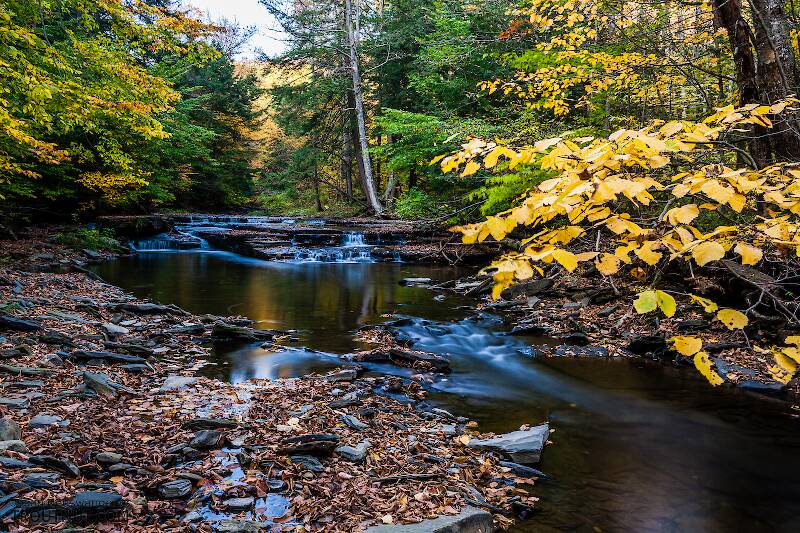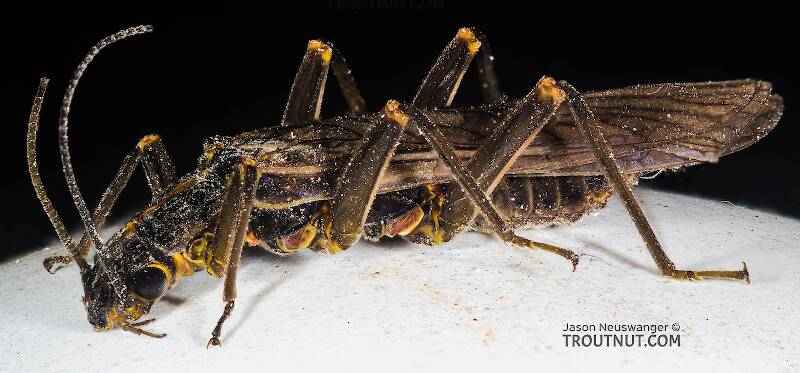
Hex Mayflies
Hexagenia limbata
The famous nocturnal Hex hatch of the Midwest (and a few other lucky locations) stirs to the surface mythically large brown trout that only touch streamers for the rest of the year.

Mayfly Species Heptagenia flavescens
Physical description
Most physical descriptions on Troutnut are direct or slightly edited quotes from the original scientific sources describing or updating the species, although there may be errors in copying them to this website. Such descriptions aren't always definitive, because species often turn out to be more variable than the original describers observed. In some cases, only a single specimen was described! However, they are useful starting points.
Male Spinner
Wing length: 11-15 mm
A large yellowish species; a broad reddish brown dorsal band on abdominal tergites; genitalia of the flavescens type (see fig. 94).
Head yellowish; vertex ferruginous; antennal filament dusky, paler at tip; eyes bright greenish yellow, in living insect. Thorax largely ferruginous dorsally, the mesonotum shaded with blackish anteriorly, on scutellum and anterior to it. Pleura largely yellowish with reddish brown shading; sternum similar. Fore legs pale ferruginous; femora with a median and apical darker band; tibiae at apex, tips of tarsi and tarsal joinings, fuscous. Basal joint of fore tarsus about 1/4 as long as the second. Middle and hind legs yellow; femora fuscous apically; tips of tarsi and tarsal joinings somewhat dusky. Basal joint of hind tarsus distinctly shorter than the second. Wings hyaline; a pale ferruginous cloud in the costo-apical region. “Veins and cross veins moderate, subequal, fuscous, except the three costal veins which are coarse, yellowish on their basal two-thirds, fuscous on their terminal one-third, where the cross veins also are coarse, the oblique basal cross vein being always very coarse; halfway to the tip the second costal vein is always thickened and obfuscated for the length of half a millimeter, sometimes obviously, sometimes indistinctly.” (Walsh). Basal costal cross veins faint.
Abdomen yellowish, with a broad reddish-brown dorsal band on the tergites, becoming yellowish red on the apical ones. Lateral margins of all tergites pale, and on the basal and middle ones are pale submedian oblique markings from the anterior margin; posterior margins of tergites 1-6 darker. Sternites pale greenish or yellowish white, the apical ones more yellow. Segments 1-6 semi-hyaline, 7-10 opaque. Forceps pale, the tips fuscous; tails whitish; joinings reddish brown in distal portion, often pale at extreme base, and in intermediate portion alternately pale and reddish. Penes rather widely spreading apically; two large somewhat conical median spines.
This species is most nearly allied to H. cruentata (now a synonym of Raptoheptagenia cruentata), but it is considerably larger; the fuscous apical portion of the costal veins, the faint basal costal cross veins and coarse apical ones, and the lack of prominent banding on the tibiae distinguish it from that species.
Start a Discussion of Heptagenia flavescens
References
- Needham, James G., Jay R. Traver, and Yin-Chi Hsu. 1935. The Biology of Mayflies. Comstock Publishing Company, Inc.


